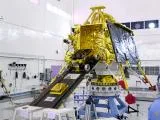Chandrayaan 2 makes exciting new discovery below moon surface.
CHACE-2 Onboard Chandrayaan-2 Orbiter makes the First Observations of the Global Distribution of Argon-40 in the Exosphere of Moon
‘Exosphere’ is the outermost region of the upper atmosphere of a celestial body where the constituent atoms and molecules rarely collide with each other and can escape into space. Earth’s Moon features a surface-boundary-exosphere. For Moon, different constituents in the exosphere are fed from the surface by a variety of processes, such as thermal desorption, solar wind sputtering, photo-stimulated desorption, and micrometeorite impact vaporization. The exospheric atoms may be lost to space by the thermal escape (also known as the Jean’s escape). Also, the atoms get ionized by photo-ionization and charge exchange with the solar wind ions. Subsequently, they can be swept away by the convective electric field of the solar wind. Some of these atoms/ions can also be deposited back on the lunar surface. Thus, the lunar exosphere exists as a result of a dynamic equilibrium between several source and sink processes.
Noble gases serve as important tracers to understand the processes of surface-exosphere interaction, and Argon-40 (Ar-40) is such an important tracer atom to study the dynamics of the lunar exospheric species. Ar-40 originates from the radioactive disintegration of Potassium-40 (K-40) present below the lunar surface. Once formed, it diffuses through the inter-granular space and makes way up to the lunar exosphere through seepages and faults.
The CHACE-2 observations provide the diurnal and spatial variation of Ar-40 covering the equatorial and mid latitude regions of the Moon. The uniqueness of this result from Chandrayaan-2 mission lies in the fact that although Apollo-17 and LADEE missions have detected the presence of Ar-40 in the lunar exosphere, the measurements were confined to the near-equatorial region of the Moon. As there is a steep latitudinal temperature gradient of the lunar surface, it was, so far, a gap area to study the global dynamics of the lunar exospheric species, which is a temperature-driven process. In this context, the observations by CHACE-2 onboard Chandrayaan-2 orbiter on Ar-40 up to the mid-latitude regions (−60º to +60º) play a significant role to bridge the gap in the knowledge.
CHACE-2 observations reveal an increase in the number density of Ar-40 near the sunrise terminator, a decrease through the dayside, a secondary peak near sunset terminator and a night-side minima. This is the typical behaviour of a condensable gas.
The variation of relative number density of Argon-40 for different solar longitudes in the near equatorial regions of the Moon observed by CHACE-2 (blue curve) compared with that of LACE/Apollo-17 observations (black curve) during March 24 to April 7, 1973. Solar longitude of 0º indicates the subsolar point (local solar time of 12 hr), 90º represents the sunset terminator (local solar time of 18 hr), 180º represents midnight (local solar time of 24 hr), and 270º indicates the sunrise terminator (local solar time of 6 hr). The black dotted curve for the solar longitudes 0º-90º and 270º-360º are from theoretical extrapolations (Hodges & Hoffman, 1974). The enhancements in the relative number density of Argon-40 during the sunrise and sunset terminators can be clearly seen.
For the mid latitude regions, CHACE-2 observations showed for the first time that the variation in the number density of Ar-40 with respect to solar longitudes are similar to that of low latitude regions, despite the differences in temperature and topography.
Further, the CHACE-2 observations reveal that the distribution in Ar-40 has significant spatial heterogeneity. There are localized enhancements (termed as Argon bulge) over several regions including the KREEP (potassium (K), rare-earth elements, and phosphorus (P)) and South Pole Aitken terrain. The observations of Argon bulge by CHACE-2 are indicative of unknown or additional loss processes, Moon quakes or regions with lower activation energies, which call for a better understanding of the surface-exosphere interactions and source distributions of Ar-40.
CHACE-2 was a sequel to the CHACE experiment on the Moon Impact Probe (MIP) of Chandrayaan-1 mission and also draws heritage from the Mars Exospheric Neutral Composition Analyser (MENCA) experiment aboard the Indian Mars Orbiter Mission.
The results are published in the journal ‘Geophysical Research Letters’, doi: 10.1029/2021GL094970.
The map of the relative number densities of Ar-40 at the surface of the Moon, where the X-axis represents the selenographic longitude and the Y-axis represents the selenographic latitude. Certain regions with enhanced Ar-40 signal are clearly seen.




No comments:
Post a Comment